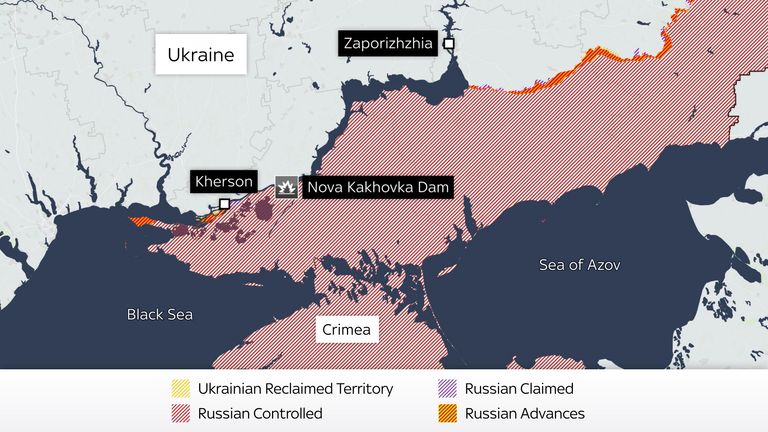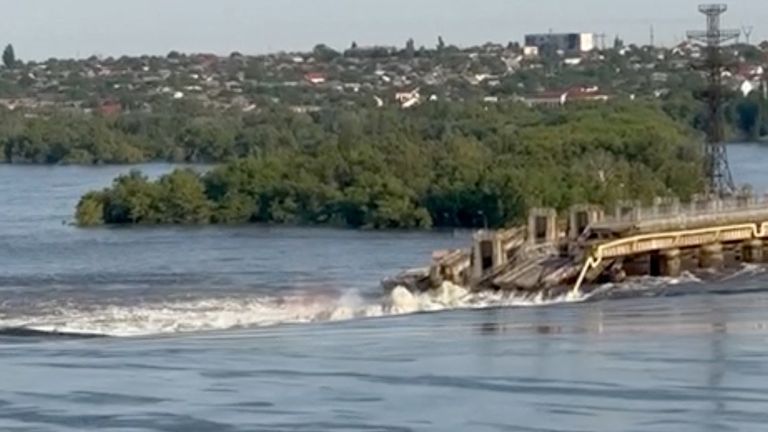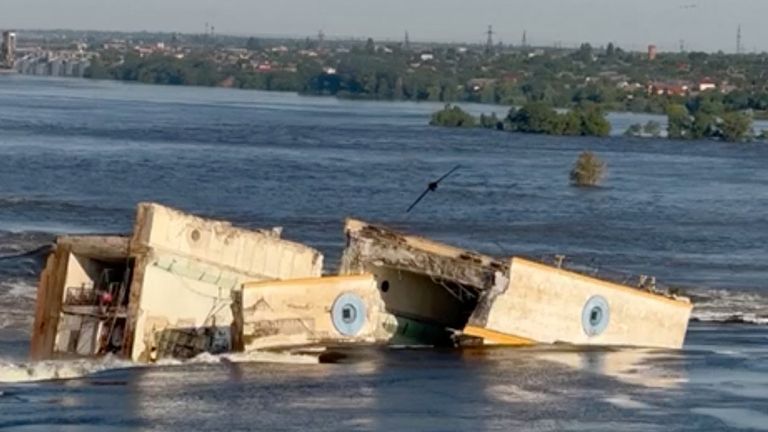Destruction of Nova Kakhovka dam could be most damaging single event of Ukraine war so far
Ukraine has long feared Moscow may seek to attack the dam to thwart efforts by their forces to move against Russian-held territory in the south
Tuesday 6 June 2023 16:16, UK
The destruction of Ukraine's giant Nova Kakhovka dam could be the most damaging single event of the war so far.
President Volodymyr Zelenskyy had previously warned an attack against the vital structure should be treated in the same way as the use of a weapon of mass destruction.
Kyiv has blamed Russia for blowing up the dam. Moscow-installed officials in territory occupied by Russia variously blamed Ukrainian shelling or claimed no attack had taken place.
Ukraine-Russia war latest: follow all the developments on our blog
Images on social media show water from the Dnipro River surging downstream towards the southern region of Kherson.
The authorities in the main city of Kherson, less than 50 miles from the dam, have warned residents in low-lying areas to evacuate to higher ground.
The dam
At 30 metres (98ft) tall and 3.2 km (2 miles) long, the Nova Kakhovka dam was built in 1956 on the Dnipro river as part of the Kakhovka hydroelectric power plant.
It holds a giant reservoir with a volume of water equal to the Great Salt Lake in the US state of Utah, according to Reuters news agency.
As well as a crucial source of energy generation, the reservoir also supplies water to the Crimean peninsula, which Russia claims to have annexed in 2014, as well as the Zaporizhzhia nuclear plant, which is also under Russian control.
Russian forces took control of the dam at the start of their February 2022 invasion.
However, Ukraine has long feared Moscow may seek to attack the dam to thwart efforts by Ukrainian forces to move against Russian-held territory in the south.
Mr Zelenskyy, last October, said Russia had mined the dam when he made the weapons of mass destruction warning.
What will be the impact of the destruction?
The most immediate impact is the risk of flooding to many thousands of civilians across huge swathes of territory downstream - both areas under Ukrainian control and under Russian occupation.
Russian-installed officials have said 22,000 people living across 14 settlements in Ukraine's southern Kherson region are at risk of flooding. They told people to be ready to evacuate.
Ukrainian Prime Minister Denys Shmyhal said that up to 80 settlements were at risk of flooding.
The Crimean peninsula - under Russian control since 2014 - will also suffer. It is dependent for fresh water on the North Crimea Canal, which is supplied by the Dnipro River.
Read more:
Has Ukraine launched a large-scale offensive? Here's what the evidence shows
Russia claims it has thwarted major Ukrainian offensive
Arms contract shows Iran has sold Russia ammunition for Ukraine war, says security source
The Russian-backed governor of Crimea said there is a risk that water levels in the canal could fall after rupture of the dam.
Ukraine previously blocked water supplies to Crimea after Russia's annexation but the flow of water resumed after Russia took control of the damn last year.
The destruction of the dam could have a devastating impact on the land across the south if it devastates a system of irrigation canals.
Nuclear plant
A close eye will be kept on the Zaporizhzhia Nuclear Power Plant, Europe's largest, which was also captured by Russia last year. The facility receives its critical cooling water from the reservoir.
The International Atomic Energy Agency, the UN's nuclear watchdog, said on Twitter it was closely monitoring what was happening but that there was "no immediate nuclear safety risk at [the] plant".
Why might Russia target the dam?
Ukraine has accused Russia of blowing up the dam. This seems plausible, coming just as Ukrainian forces appear to be in the initial phases of a major counter-offensive against Russian positions in the south and the east.
Rather than concentrate attention on their offensive operation, the Ukrainian government will have to focus on dealing with this disaster.
It could force the evacuation of huge numbers of people as well as flooding vast areas of land.
Any mass flooding will also surely make military operations in the area much harder.



